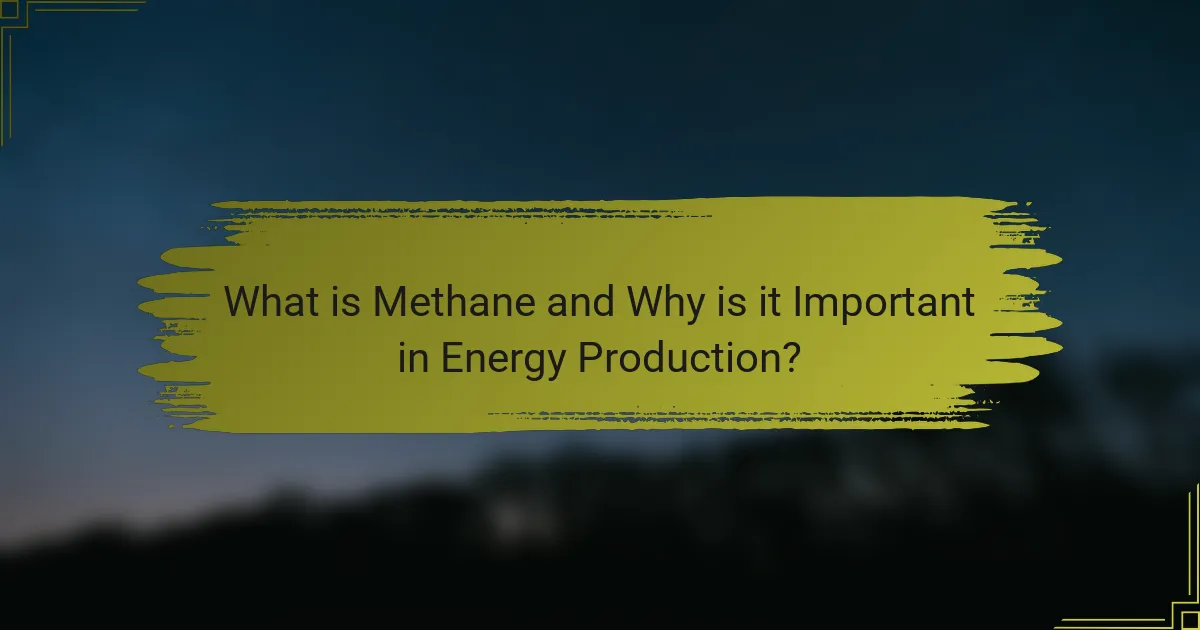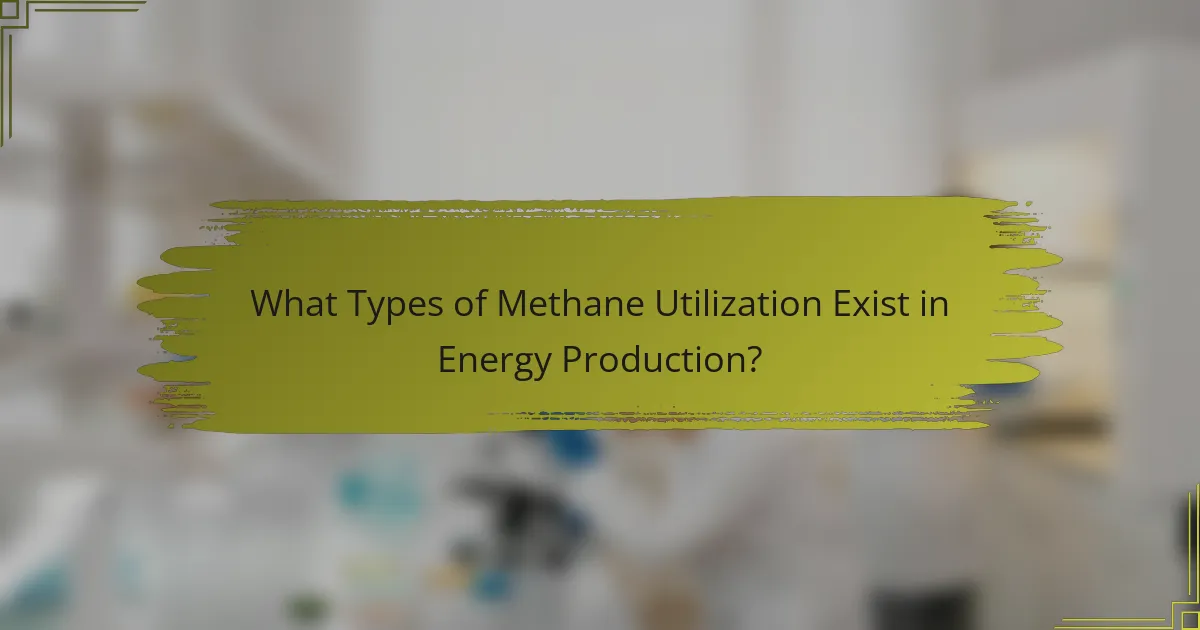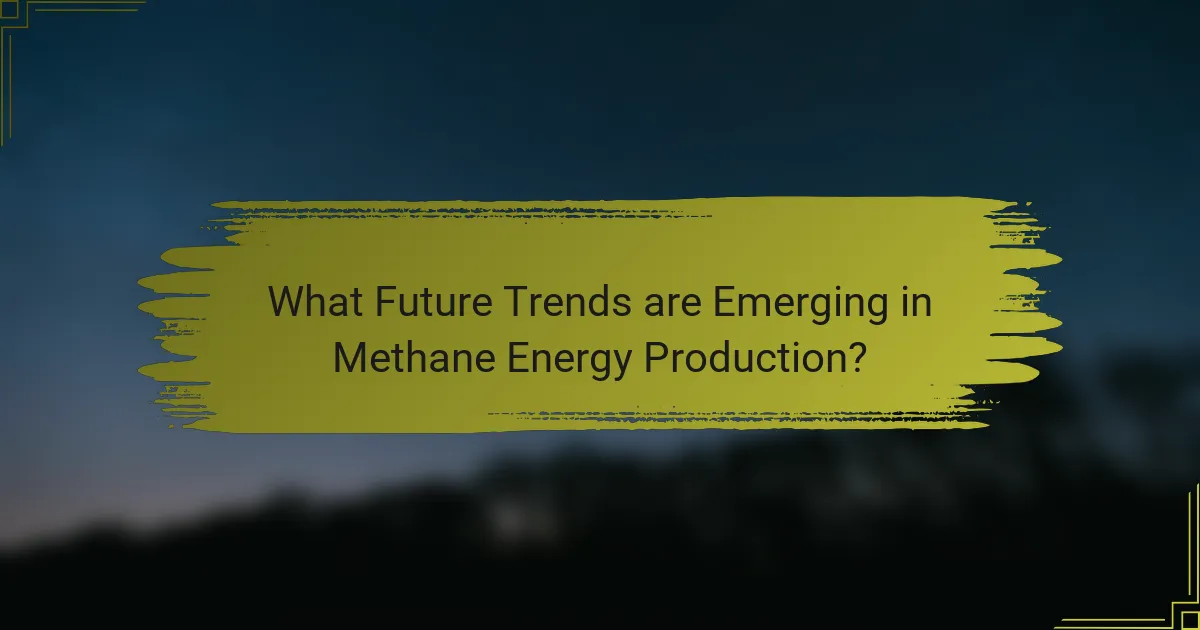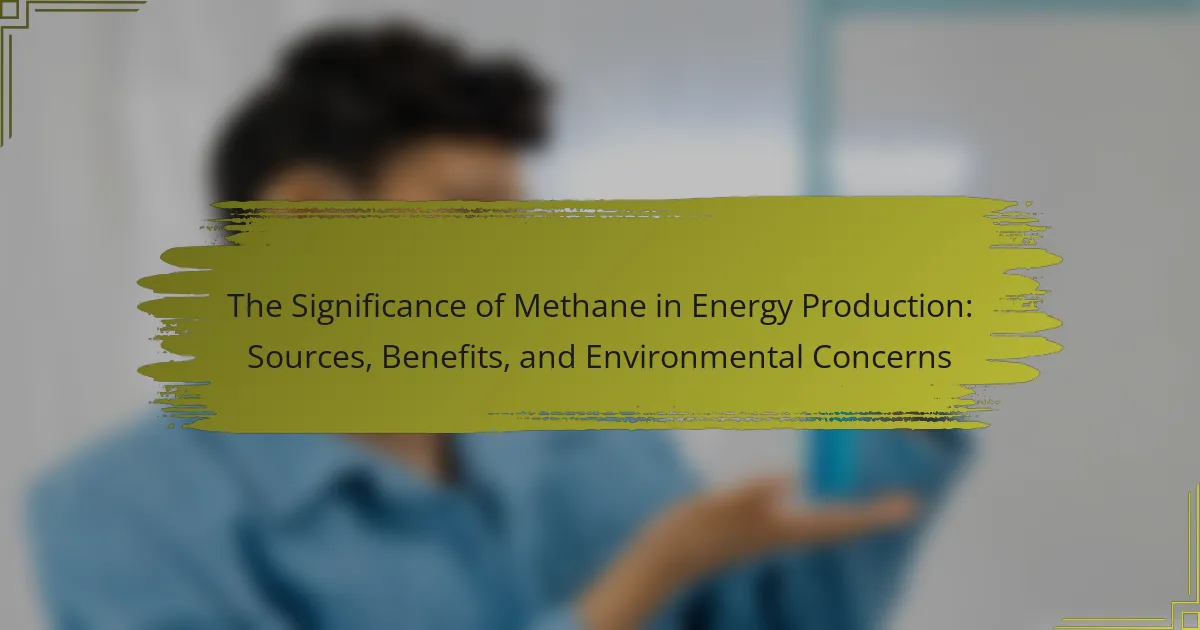
What is Methane and Why is it Important in Energy Production?
Methane is a colorless, odorless gas that is a primary component of natural gas. It is produced during the decomposition of organic matter in environments without oxygen. Methane is significant in energy production as it serves as a cleaner-burning fossil fuel compared to coal and oil. When burned, it emits less carbon dioxide per unit of energy. According to the U.S. Energy Information Administration, methane accounts for about 10% of U.S. energy consumption. It is also used in the production of hydrogen, which is essential for various industrial processes. Methane’s role in energy production is crucial for transitioning to lower-carbon energy sources.
How is Methane Produced?
Methane is produced primarily through natural processes such as anaerobic digestion and geological processes. Anaerobic digestion occurs when organic matter decomposes in the absence of oxygen, often in landfills and digestive systems of ruminant animals. This process generates methane as a byproduct. Geological processes involve the breakdown of organic materials over millions of years under high pressure and temperature, forming natural gas reservoirs. Additionally, methane is released during the extraction and transportation of fossil fuels. According to the U.S. Environmental Protection Agency, agriculture and landfills are significant sources, contributing approximately 60% of methane emissions in the United States.
What are the primary natural sources of Methane?
The primary natural sources of methane include wetlands, termites, oceans, and geological seeps. Wetlands produce methane through anaerobic decomposition of organic matter. Termites generate methane as a byproduct of digestion. Oceans release methane from microbial processes in sediments. Geological seeps allow methane to escape from underground reservoirs. According to the Intergovernmental Panel on Climate Change, these natural sources contribute significantly to the global methane emissions.
How do human activities contribute to Methane production?
Human activities significantly contribute to methane production through various processes. Agriculture, particularly livestock farming, generates methane during digestion in ruminants. Landfills produce methane as organic waste decomposes anaerobically. Natural gas extraction and distribution release methane during drilling and transportation. Additionally, rice cultivation emits methane due to anaerobic conditions in flooded fields. According to the Environmental Protection Agency, these sources combined account for over 60% of global methane emissions.
What are the Key Benefits of Using Methane as an Energy Source?
Methane is a highly efficient energy source with several key benefits. It produces more energy per unit than other fossil fuels, making it a potent option for power generation. Methane combustion emits lower levels of carbon dioxide compared to coal and oil, contributing to reduced greenhouse gas emissions. It also generates less particulate matter and sulfur dioxide, improving air quality. Methane is abundant and can be sourced from natural gas fields, landfills, and agricultural waste. This versatility allows for diverse applications, including heating, electricity generation, and as a transportation fuel. Utilizing methane can enhance energy security by reducing dependence on oil imports. Additionally, advancements in extraction and production technologies are making methane more accessible and cost-effective.
How does Methane compare to other fossil fuels in terms of efficiency?
Methane is more efficient than many other fossil fuels in energy production. It has a higher energy content per unit than coal or oil. Methane’s combustion produces less carbon dioxide per energy unit generated. For example, burning methane releases about 55% less CO2 than coal. Additionally, methane’s combustion efficiency can reach around 90%. This is significantly higher compared to oil and coal, which typically have lower combustion efficiencies. The efficiency of methane makes it a preferred choice in many power generation scenarios.
What role does Methane play in the transition to renewable energy?
Methane serves as a critical bridge fuel in the transition to renewable energy. It emits less carbon dioxide than coal and oil when burned, making it a cleaner alternative. This characteristic allows methane to support the reduction of greenhouse gas emissions during the energy transition. Furthermore, methane can be produced from renewable sources, such as biogas from organic waste. This renewable methane contributes to a sustainable energy system. According to the International Energy Agency, using methane can help facilitate the integration of intermittent renewable sources like wind and solar. Thus, methane plays a significant role in providing reliable energy while reducing overall carbon emissions.
What Environmental Concerns are Associated with Methane?
Methane is a potent greenhouse gas that significantly contributes to climate change. It has a global warming potential that is 25 times greater than carbon dioxide over a 100-year period. Methane emissions primarily arise from agricultural activities, landfills, and fossil fuel extraction. These emissions can lead to increased atmospheric temperatures, which exacerbate extreme weather events. Furthermore, methane can contribute to the formation of ground-level ozone, a harmful air pollutant. According to the Environmental Protection Agency, methane accounted for about 10% of total U.S. greenhouse gas emissions in 2020. Addressing methane emissions is crucial for achieving climate goals and improving air quality.
How does Methane impact climate change compared to other greenhouse gases?
Methane significantly impacts climate change, more than carbon dioxide in the short term. Over a 20-year period, methane is 84 times more effective at trapping heat than carbon dioxide. This potency makes methane a crucial greenhouse gas to address. Methane emissions primarily come from agriculture, landfills, and fossil fuel production. In 2021, methane accounted for about 30% of global warming. Reducing methane emissions could have immediate benefits for climate stabilization. Effective strategies include improving agricultural practices and reducing waste. Addressing methane is essential for meeting climate goals.
What are the risks of Methane leaks during extraction and transportation?
Methane leaks during extraction and transportation pose significant environmental and safety risks. These leaks can lead to greenhouse gas emissions that contribute to climate change. Methane is a potent greenhouse gas, with a global warming potential many times greater than carbon dioxide over a short time frame. Additionally, methane leaks can create explosive hazards in confined spaces. The U.S. Environmental Protection Agency estimates that methane emissions from the oil and gas sector are responsible for about 25% of the sector’s total greenhouse gas emissions. Furthermore, leaks can also result in economic losses due to wasted resources and regulatory fines. Addressing these risks requires stringent monitoring and maintenance practices throughout the extraction and transportation processes.

What Types of Methane Utilization Exist in Energy Production?
Methane can be utilized in energy production through several methods. The primary types include combustion, biogas production, and fuel cells. Combustion involves burning methane to generate heat and electricity. This process is common in natural gas power plants. Biogas production occurs through anaerobic digestion of organic materials. This method captures methane from waste, which can then be used for energy. Fuel cells convert methane directly into electricity with high efficiency. Each method contributes to energy production while addressing environmental concerns associated with methane emissions.
How is Methane used in electricity generation?
Methane is used in electricity generation primarily through combustion in gas turbines and internal combustion engines. These systems convert the chemical energy in methane into mechanical energy. This mechanical energy is then transformed into electrical energy via generators. Methane can also be utilized in combined heat and power (CHP) systems. In CHP, the waste heat from electricity generation is captured for heating purposes. Methane’s efficiency in these processes can reach up to 60% in CHP systems. According to the U.S. Energy Information Administration, natural gas, which is primarily methane, accounted for about 40% of U.S. electricity generation in 2021. This highlights methane’s significant role in the energy sector.
What technologies are involved in converting Methane to electricity?
Methane can be converted to electricity using several technologies. These include combustion in gas turbines, internal combustion engines, and fuel cells.
In combustion, methane is burned to generate heat, which produces steam that drives turbines. Gas turbines can achieve high efficiency in electricity generation.
Internal combustion engines also utilize methane, converting its chemical energy into mechanical energy to generate electricity. These engines are commonly used in distributed energy systems.
Fuel cells convert methane directly into electricity through electrochemical reactions. This method is highly efficient and produces fewer emissions compared to combustion.
Overall, these technologies enable the effective conversion of methane into electricity while addressing efficiency and environmental concerns.
How does the efficiency of Methane power plants compare to others?
Methane power plants exhibit higher efficiency compared to many traditional power plants. They typically achieve thermal efficiencies of 40% to 60%. This is significantly better than coal power plants, which average around 33% efficiency. Natural gas combined cycle plants, which also utilize methane, can reach efficiencies of up to 62%. The efficiency of methane plants is due to advanced technologies like combined heat and power systems. These systems capture waste heat for additional energy production. Therefore, methane power plants are generally more efficient than coal and oil-based plants. This efficiency contributes to lower greenhouse gas emissions per unit of electricity generated.
What are the applications of Methane in transportation fuels?
Methane is increasingly used as a transportation fuel. It serves primarily as compressed natural gas (CNG) and liquefied natural gas (LNG). CNG powers light-duty vehicles, buses, and trucks. LNG is suitable for heavy-duty trucks and ships. Methane combustion produces lower greenhouse gas emissions compared to gasoline and diesel. It can reduce particulate matter and nitrogen oxides in exhaust. The use of methane in transportation supports energy diversification. It enhances energy security by utilizing domestic resources.
What types of vehicles can utilize Methane as fuel?
Vehicles that can utilize methane as fuel include compressed natural gas (CNG) vehicles and bi-fuel vehicles. CNG vehicles are specifically designed to run on methane. Bi-fuel vehicles can operate on both gasoline and methane. Additionally, heavy-duty trucks and buses often use methane to reduce emissions. Methane is a cleaner alternative to gasoline and diesel. Its use in transportation contributes to lower greenhouse gas emissions. According to the U.S. Department of Energy, CNG vehicles can reduce carbon dioxide emissions by up to 30%.
How does Methane fuel affect emissions in transportation?
Methane fuel significantly reduces emissions in transportation compared to traditional fossil fuels. When combusted, methane produces less carbon dioxide (CO2) per unit of energy than gasoline or diesel. Specifically, methane emits about 25% less CO2 than gasoline. Additionally, methane combustion results in lower particulate matter and nitrogen oxides (NOx) emissions. This reduction contributes to improved air quality and lower greenhouse gas emissions. According to the U.S. Department of Energy, using compressed natural gas (CNG), which is primarily methane, can reduce greenhouse gas emissions by up to 30%. Thus, methane fuel presents a cleaner alternative for transportation, contributing to overall emission reductions.

What Future Trends are Emerging in Methane Energy Production?
Emerging trends in methane energy production include advancements in biogas technology and carbon capture methods. Biogas production from organic waste is gaining traction. This process converts agricultural and food waste into methane, enhancing renewable energy sources. Carbon capture and storage (CCS) technologies are evolving to reduce methane emissions during production. Innovations in methane hydrate extraction are also being explored. These hydrates, found in ocean sediments, offer a potential new energy source. Additionally, the use of methane as a hydrogen carrier is being researched. This approach could facilitate cleaner energy transitions. Overall, these trends indicate a shift towards more sustainable methane energy production.
How is technology advancing the capture and use of Methane?
Technology is advancing the capture and use of methane through improved detection and conversion methods. New sensors enhance the ability to locate methane leaks in pipelines and storage facilities. These sensors provide real-time data, allowing for quicker responses to leaks. Additionally, advancements in biogas technology enable the conversion of organic waste into methane. This process captures methane that would otherwise be released into the atmosphere. Furthermore, innovations in methane reforming techniques create hydrogen from methane, promoting cleaner energy production. Research indicates that capturing and utilizing methane can significantly reduce greenhouse gas emissions. For example, the Global Methane Initiative reports that capturing methane can prevent the release of up to 1.5 billion tons of CO2 equivalent annually.
What innovations are being developed to reduce Methane emissions?
Innovations to reduce methane emissions include advanced biogas technologies and methane capture systems. Biogas technologies convert organic waste into renewable energy while capturing methane. These systems can significantly lower emissions from landfills and agricultural operations. Additionally, methane detection sensors improve leak identification in natural gas infrastructure. Research shows that implementing these innovations can reduce methane emissions by up to 50% in targeted sectors. Furthermore, developing feed additives for livestock can decrease enteric methane production. These innovations are vital in mitigating climate change impacts associated with methane emissions.
How can Methane be integrated with renewable energy sources?
Methane can be integrated with renewable energy sources through biogas production and power generation. Biogas is generated from organic waste, which includes methane as a primary component. This biogas can be captured and utilized in combined heat and power systems. These systems convert the thermal energy from biogas into electricity and heat, thus enhancing energy efficiency.
Additionally, methane can serve as a storage medium for excess renewable energy. For instance, during periods of high renewable energy generation, surplus energy can be used to produce hydrogen through electrolysis. This hydrogen can then be combined with carbon dioxide to produce methane via the Sabatier reaction.
Integrating methane with renewable energy sources helps reduce greenhouse gas emissions. The use of methane from biogas significantly lowers carbon footprints compared to fossil fuels. According to the U.S. Environmental Protection Agency, capturing and using methane can prevent over 20 million metric tons of carbon dioxide equivalent emissions annually.
This integration supports energy resilience and stability in power supply. By utilizing methane alongside renewable sources, energy systems can maintain consistent output, even when renewable generation fluctuates.
What Best Practices Should be Followed for Methane Management?
Implementing best practices for methane management involves several key strategies. Regular monitoring of methane emissions is essential to identify sources and quantify levels. Utilizing advanced leak detection technologies can enhance the accuracy of monitoring. Proper maintenance of equipment and infrastructure reduces the risk of leaks. Implementing best management practices in agricultural operations can also minimize methane emissions. For example, optimizing livestock diets can decrease enteric fermentation emissions. Additionally, capturing methane from landfills and wastewater treatment facilities for energy use is beneficial. According to the Environmental Protection Agency, effective methane management can significantly reduce greenhouse gas emissions and improve air quality.
How can industries minimize Methane emissions effectively?
Industries can minimize methane emissions effectively by implementing advanced technologies and best practices. They can adopt leak detection and repair (LDAR) programs to identify and fix leaks in infrastructure. Regular maintenance of equipment and pipelines reduces the likelihood of methane release. Industries can also switch to low-emission technologies, such as using biogas instead of fossil fuels. Capturing methane from landfills and agricultural operations for energy use further decreases emissions. According to the U.S. Environmental Protection Agency, these measures can significantly reduce overall methane emissions. Implementing these strategies leads to both environmental benefits and cost savings for industries.
What strategies are effective for capturing and utilizing Methane sustainably?
Effective strategies for capturing and utilizing methane sustainably include anaerobic digestion, landfill gas recovery, and biogas production. Anaerobic digestion involves breaking down organic matter in the absence of oxygen, producing methane as a byproduct. This method can convert agricultural waste and food scraps into renewable energy. Landfill gas recovery captures methane emitted from decomposing waste in landfills. This process can reduce greenhouse gas emissions and provide a source of energy. Biogas production from manure and waste can also be harnessed for heating or electricity generation. According to the U.S. Environmental Protection Agency, these methods can significantly reduce methane emissions while providing sustainable energy solutions.
Methane, a colorless and odorless gas, is a crucial component of natural gas and plays a significant role in energy production due to its cleaner-burning properties compared to coal and oil. This article explores the sources of methane, including natural processes and human activities, while highlighting its benefits as an efficient energy source that contributes to lower greenhouse gas emissions. It also addresses environmental concerns associated with methane, such as its impact on climate change and the risks of leaks during extraction and transportation. Furthermore, the article discusses emerging trends in methane utilization, including advancements in technology for capturing and using methane sustainably.
